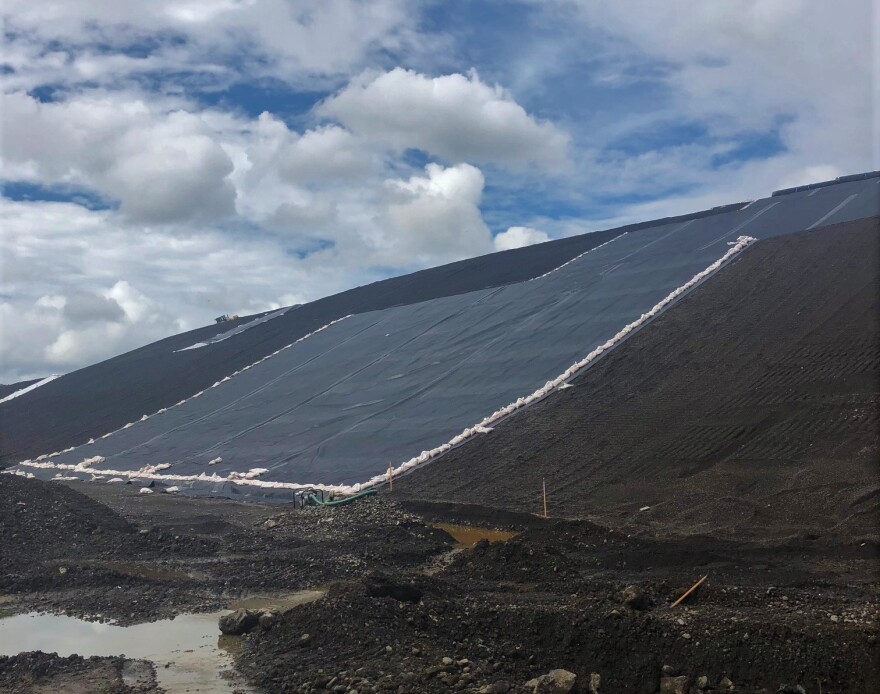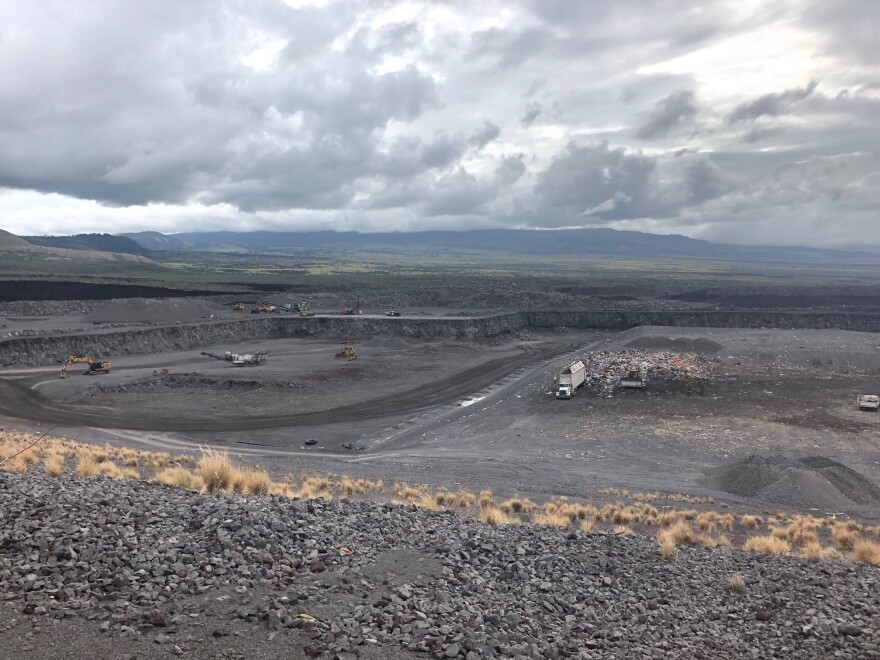Hawaii Island is in the enviable position of having a landfill with anywhere from 20 to 100 years of capacity left to take in trash. But the island still wrestles with significant issues like plastic products that are no longer being recycled.
For the past four decades, trash from the east side of Hawaii Island has been dumped in a landfill outside of Hilo. But now trash from all parts of the island is being trucked to a facility north of Kona.
The South Hilo Sanitary Landfill predates current federal regulations from the Environmental Protection Agency, known as Subtitle D, which mandate environmental safety measures like industrial plastic liners and collection systems for contaminated runoff known as leachate.
Officials with Hawaii County and the state Department of Health have been discussing the eventual closure of the facility since Subtitle D took effect in 1991. But county waste managers say their groundwater monitoring showed no signs of adverse impact from the landfill, leading them to prolong its life.
The calculus changed in 2019, when Hilo landfill reached capacity. State regulators chose not to approve an expansion and Hawaii County announced that it would close the Hilo landfill before the end of the year. That closure became official in November, when the facility stopped accepting new deposits of trash.
Work is already underway to permanently close the facility. The process involves covering the mountain of trash with sand and gravel, before topping it with an impermeable plastic liner.

Once the liner is in place, a top layer of AstroTurf-like artificial grass will be laid down. According to county Environmental Director Bill Kucharski, this is the first time such a process has been used in Hawaii.
While many landfills across the U.S. are topped with real grass, Hilo’s wet climate raised concerns that vigorous plant growth could puncture the single plastic liner without an additional layer. County officials visited facilities in Puerto Rico and Florida, which have similar climates to Hilo, where the AstroTurf material has been used effectively.
LANDFILL CONTAMINATION STILL POSSIBLE
As of early December, rotting trash could still be smelled at the landfill in Hilo. Bulldozers and other heavy construction equipment drove across a trash mountain, rising over 100 feet into the air.
Most of the pile had already been covered in gravel aggregate, with some sections of the plastic liner already in place. The semi-rigid material arrives to the landfill in giant spools, which are unrolled and held in place by sandbags.
When work is complete, possibly as soon as this summer, decades’ worth of trash should be sealed off from the outside environment. The aim is to prevent rainwater from reaching the trash pile and creating contaminated runoff.
A smaller transfer station will continue to operate on the premises. All of the refuse from the east side of Hawaii Island will be temporarily deposited here, before being loaded on to specialty flatbed trucks and hauled to the Pu?uanahulu landfill on the west side of the island.

The trash haulers resemble 18-wheeler shipping trucks, more than they do municipal garbage vehicles. Clam-shell doors top a rectangular hold, allowing the vehicles to quickly load up trash, which is pushed from above by a bulldozer.
These trucks were purchased by the county specifically with this transition in mind. Eight will make the daily trip from Hilo to Pu?uanahulu, a drive that takes a car around 90 minutes. Some residents have expressed concern over the associated carbon emissions and increased vehicle traffic on Daniel K. Inouye Highway (Saddle Road), the main cross-island artery.
But officials like Kucharski, and Solid Waste Manager Greg Goodale say keeping the Hilo landfill open was no longer an option. In addition to regulatory issues, there was also another problem: birds.
“You get a lot of egrets that come here and they feed on the flies,” Goodale said. “Ultimately, because of our proximity to the airport, [the] state Department of Transportation Airports Division said, ‘No more expansion of the landfill.’”
That left the county’s only remaining landfill, Pu?uanahulu, as the best option. The site is located in arid West Hawaii, making leachate less of a threat. The facility also has decades’ worth of trash capacity, anywhere from 50 to 100 years, according to Kucharski.
Pu?uanahulu is also fully compliant with the EPA’s Subtitle D rules, including plastic liners below each section of the landfill, called cells.

The exact amount of remaining capacity is difficult to pin down. It’s determined by a mix of variables, including the amount of trash produced, what materials make up the waste stream, and what method of compaction is used.
Changes in those factors are allowing the Pu?uanahulu facility to operate well beyond its original lifespan of 30 years. After 27 years of accepting trash, it's only around half full.
That’s in part because the county has been diverting organic green waste from the landfill for more than a decade. Currently, 40,000 tons of material are redirected each year and used to create mulch, which residents can use to create new soil.
The service has proven popular, so much that the county can’t make enough mulch to meet demand in rainy East Hawaii. But mulch often sits unused on the dry west side.
So after dropping waste from Hilo at Pu?uanahulu, the trash trucks will load up on mulch and bring it to East Hawaii. Officials hope this will help, at least in part, to address community concerns trucking waste from one side of the island to the other.
LOTS OF CAPACITY BUT REDUCTION, DIVERSION STILL NEEDED
Hawaii County’s low population density, surplus of undeveloped land, and multi-decade landfill capacity are enviable in the world of solid waste management. But local managers like Kucharski say that creates the risk of complacency.
“Because we have room, because we have the capacity, doesn’t mean we should just say, ‘Well, we don't have a problem.’ We still need to be able to manage the solid waste in a sound and environmentally responsible way,” he said following a tour of the Hilo site.
For Kucharski, that means further reducing the production of trash on the island and finding new ways to divert disposed products from the landfill.

Hawaii County Councilmember Tim Richards has asked the county’s Research and Development Department to explore how to further reduce solid waste, roughly 600 tons of which are currently generated each day.
“Of that 600 tons, estimates are that about 50 percent is biological, whether it be green waste or food. Let's get that out, let's compost it, let's do something else with it, and then start working on the other side,” Richards said.
After several years of setbacks, the county is moving ahead with developing an industrial composting facility that has the potential to keep organic materials out of the landfill.
Another idea for waste stream reduction is to replace disposable plastic with biodegradable alternatives. As the global recycling industry has been rocked by a wave of Asian countries no longer accepting plastic recycling, Hawaii County has had to stop accepting plastics as part of its recycling program.
For the time being, most of those materials will now be sent to the landfill, effectively increasing the quantity of waste being generated.
Officials like Council member Richards are also exploring how to turn trash into something useful. One possibility being floated is capturing methane released from the landfill and converting it into clean-burning hydrogen fuel for public transit buses.
Supporters of the idea say it’s a way to transform waste from a liability to an asset.
This story is part of our series "Trashing The Islands," a look at the state's mounting trash problems. We'd like to hear your comments on our stories and questions you have about dealing with our trash problem. Call us on our Talk Back line at (808) 792-8217 and leave your comment, name and phone number. Or email us at news@hawaiipublicradio.org, tweet us @wearehpr or comment on Facebook.
Correction: This story originally stated that Waste Management was overseeing the South Hilo Sanitary Landfill. Waste Management operates the Pu'uanahulu Landfill on West Hawaii Island.




